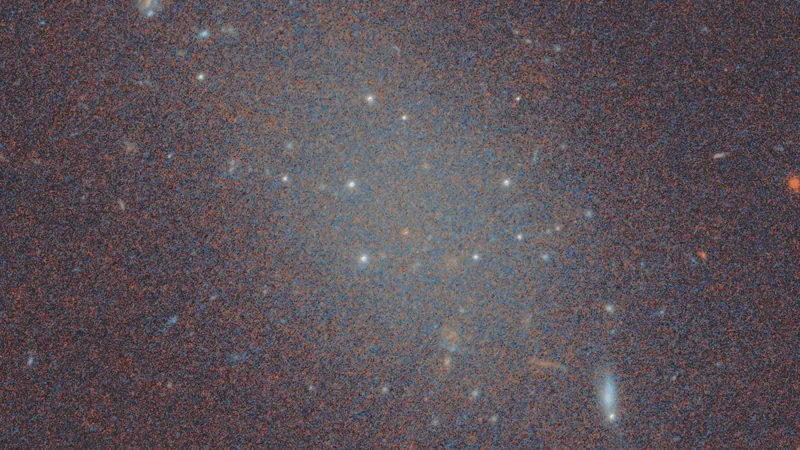
Astronomers Stunned by Discovery of Dark Matter-Free Galaxy
2025-04-25
Author: Yu
A Mysterious Discovery in the Cosmos
Astronomers have unearthed a bewildering cosmic enigma: a ghostly galaxy that seems entirely free of dark matter, the elusive substance that scientists believe plays a crucial role in the formation and structure of galaxies. This revelation raises questions as perplexing as finding a shadow without its source!
Meet FCC 224: A Galactic Puzzle
The latest addition to this curious category of galaxies is FCC 224, located on the outskirts of the Fornax Cluster, a mere 65 million light-years from Earth. First observed in 2024, FCC 224 is a dwarf galaxy strikingly similar in size to our Milky Way but notably lacking in stars. Surprisingly, it hosts a dozen luminous clusters of stars, an unusual abundance for its size—something typically found in larger galaxies rich with dark matter.
The Search for Answers
Maria Buzzo, an astrophysics doctoral candidate at Swinburne University in Australia and a lead researcher in a new study, stated, "No existing galaxy formation model can currently explain how this galaxy came to be." Using intricate data from the Keck Observatory in Hawaii, Buzzo and her team observed the movement of the star clusters in FCC 224. Their findings indicated a notably slow speed among these clusters, pointing towards a lack of the strong gravitational pull expected from dark matter.
Exploring Cosmic Connections
Meanwhile, another research group, led by Yimeng Tang at the University of California, Santa Cruz, drew parallels between FCC 224 and other dark matter-deficient galaxies located in the NGC 1052 group, also about 65 million light-years away. Their theory suggests that FCC 224 may have originated from a high-velocity collision of gas-rich galaxies, a scenario where gas escapes dark matter, leading to the formation of one or more dark-matter-free galaxies.
The Twin Theory
As prior research indicated that galaxies DF2 and DF4 in the NGC 1052 group were part of a cluster of galaxies formed from a similar cosmic event, Tang's team posits that FCC 224 may also have a twin. A prime candidate is FCC 240, which appears strikingly similar in size, shape, and orientation. Future observations may confirm this connection and potentially validate the collision hypothesis for FCC 224.
A Chaotic Birth?
Alternatively, Tang’s team speculates that FCC 224 could have emerged from a high-energy environment where vigorous star formation led to the expulsion of dark matter from the galaxy, creating its unique characteristics.
Charting New Territories in Astronomy
Buzzo emphasizes the significance of this discovery: "FCC 224 serves as a crucial data point in our effort to identify and study other dark-matter-deficient galaxies. By expanding our sample size, we can better understand these rare cosmic wonders and clarify the role that dark matter plays in the formation of dwarf galaxies."


 Brasil (PT)
Brasil (PT)
 Canada (EN)
Canada (EN)
 Chile (ES)
Chile (ES)
 Česko (CS)
Česko (CS)
 대한민국 (KO)
대한민국 (KO)
 España (ES)
España (ES)
 France (FR)
France (FR)
 Hong Kong (EN)
Hong Kong (EN)
 Italia (IT)
Italia (IT)
 日本 (JA)
日本 (JA)
 Magyarország (HU)
Magyarország (HU)
 Norge (NO)
Norge (NO)
 Polska (PL)
Polska (PL)
 Schweiz (DE)
Schweiz (DE)
 Singapore (EN)
Singapore (EN)
 Sverige (SV)
Sverige (SV)
 Suomi (FI)
Suomi (FI)
 Türkiye (TR)
Türkiye (TR)
 الإمارات العربية المتحدة (AR)
الإمارات العربية المتحدة (AR)